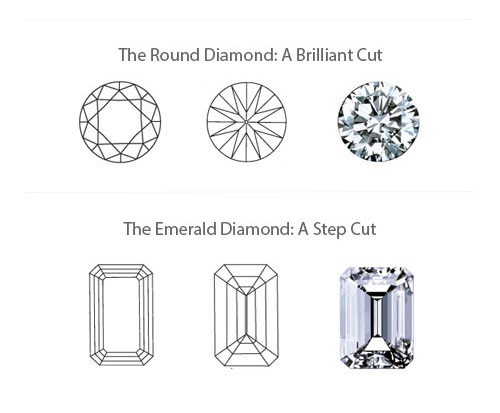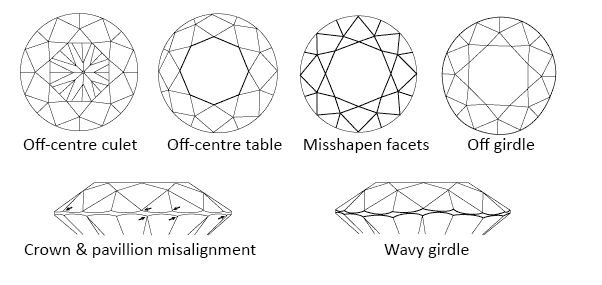DIAMOND CUT
A Cut grade is applied to a diamond based on how well that has been fashioned from the original rough stone.
The Cut of a diamond influences how well the diamond facets interact with light, which in turn determines the brilliance, dispersion and scintillation.
What is brilliance, dispersion and scintillation?
Brilliance - this is the internal and external white light which is reflected from the diamond
Dispersion - this is also known as Fire and refers to the dispersion of white light into rainbow colours when it hits the facets of the diamond.
Scintillation - this is the contrast between darker and lighter areas within the diamond. The unique flashes of light from facet to facet when the diamond is moved (the sparkle).
The Cut of a diamond can often be confused with the Shape but the two are entirely different. The Cut, as we’ve mention above, is how well the diamond has been fashioned from the original rough stone.
The Shape is the outline of the diamond and gives you options such as Round, Oval, Marquise and other fancy shape diamond.
A Cut grade will only be applied to a Round diamond and below we talk about the different grades...

This is the highest Cut grade which can be applied to a diamond.
Diamonds graded Excellent or Ideal have been proportioned perfectly and fashioned precisely to create the maximum sparkle. They will reflect the maximum amount of light from the diamond.
Diamonds with an Excellent or Ideal Cut grade are incredibly rare and this grade represents the top 3% of diamonds in the world. For this reason they do come at a higher price.
If sparkle is very important to you then we would recommend this Cut grade.
Very good cutDiamonds with this grade are almost indistinguishable from those graded Excellent or Ideal to the naked eye.
While the difference between Very Good and Excellent/Ideal is slight they do come at a lower price and therefore offer great value for money.
Very Good Cut diamonds are also very rare and sought after being in the top 15% in the world.
Very Good is usually the Cut grade we’d recommend along with VS2 Clarity and F Colour. Those selections will give a stunning diamond without choosing the highest and most expensive options throughout. If you would like any advice on your diamond choice please just get in touch.
Good cutDiamonds graded Good will reflect a good amount of light from the diamond and still offer a high degree of sparkle.
These diamonds will not appear dull; however, they won’t offer as much sparkle as an Excellent/Ideal or Very Good Cut diamond.
The Good Cut represents around 25% of the diamonds in the world.
Good Cut diamonds do offer great value for money and are a good option for customers working with a certain budget.
Fair Cut and Poor CutThese diamonds do still have some sparkle but as they lose most of their light out of the sides and bottom of the diamond they have considerably less than the Good Cut.
Fair and poor Cut diamonds have very little brilliance, dispersion and sparkle making them visually less appealing.
For these reasons we don’t recommend, source or offer diamonds of this Cut grade as they do not meet the standard of the high quality jewellery we offer.

So far we’ve talked about the Cut in relation to how well the diamond has been fashioned. There are, however, two different types of Cut and that is why some diamonds look and sparkle differently.
What does Brilliant Cut and Step Cut mean?
Brilliant Cut is the most commonly used style for cutting diamonds. The original and most well known of this style is the Round Brilliant Cut. We now have modified Brilliant Cuts like the Princess, Marquise and Heart which are fashioned from the Round Brilliant Cut.
The Round Brilliant Cut has 58 triangular shaped facets which allow optimum sparkle and maximum brilliance and dispersion.
Most modified Brilliant Cut diamonds have around 56 to 58 facets but the Radiant Cut will usually consist of 70 facets.
What is a Facet?
A diamond facet is a flat surface on the diamond. Every shape and cut has multiple facets and these facets are what allow the diamond to absorb, reflect and refract light.
A Step Cut diamond has elongated facets which are placed in rows. An example of the Step Cut would be the Emerald and Asscher shapes.
Some shapes, like the Cushion, are mixture of both cutting styles and they’re called mixed cuts.
Each cutting style is unique and has its own light-reflecting properties.
Step Cut diamonds do still sparkle but just in a different way to the Brilliant Cut. They are slightly simpler in presentation with a less cluttered look.
It is important to keep in mind that Step Cut diamonds will make any inclusions appear more obvious. This cutting style has a larger, plain surface on top of the diamond (the table) which is a more clear space to see the inclusions.
Emerald diamonds usually have 57 facets and Asscher diamonds have around 50 to 58.

The four C’s (Carat, Clarity, Colour and Cut) are the main specifications to consider when purchasing a diamond. For this reason, you can make your own selection for those specifications online.
There are other specifications, like Fluorescence, Polish and Symmetry, which are also important.
We will always source the best possible diamond available for our customers based on the specifications chosen online. We have minimum grades which we source for the Fluorescence, Polish and Symmetry but if you have any specific requirements for those please just get in touch.
Polish is the degree of smoothness of each facet of the diamond.
Symmetry is the placement and alignment of the facets.
You can read all about the Fluorescence here.
The Polish and Symmetry do influence the Cut grade which is applied to the diamond.
You can see some examples of flaws in diamond symmetry below. Poor Symmetry, such as an off centre table, may reduce the sparkle of the diamond.

After the cutting process is complete each facet must be polished. If scratches or polish lines remain after this process then the light performance can be affected. This would result in a lower Polish grade.
A poor Polish grade can make the diamond appear dull or slightly blurred. Where there are no scratches or polish lines a higher Polish grade can be applied. A higher grade can help obtain maximum sparkle for the diamond.
Why can’t I choose the Cut grade for a fancy shape diamond like the Princess, Oval and Marquise shapes?
A Cut Grade is only applied to Round diamonds. They are, in principle, easier to measure in terms of light reflection and refraction.
The Gemmological Institute of America (GIA) which is the largest and most reputable grading lab currently state this to be the case.
‘An internationally accepted system for visually evaluating the appearance of fancy-cut diamonds does not exist at this time. At GIA, research is underway to develop the basic concepts for designing and implementing such a system’. - https://www.gia.edu/gia-faq-analysis-grading-system-fancy-shape-diamond
We always source the best possible diamond available to meet your chosen specifications. In terms of dimensions we work within certain parameters, ratios and proportions for fancy shape diamonds that would make them considered to be the equivalent to Very Good/Excellent.
Is Cut the most important of the four C’s?
You may have heard many people say that Cut is the absolute most important specification to consider when choosing your diamond. In reality though, there isn’t just one specification that can be seen as the most important.
The choices you make for your diamond will be based on your personal preference and budget. For instance, if sparkle is the most important to you then you may choose to go for a higher Cut grade over Colour.
Each selection is equally as important to get the best possible diamond you can overall. If you need any help with this please don’t hesitate to get in touch.






